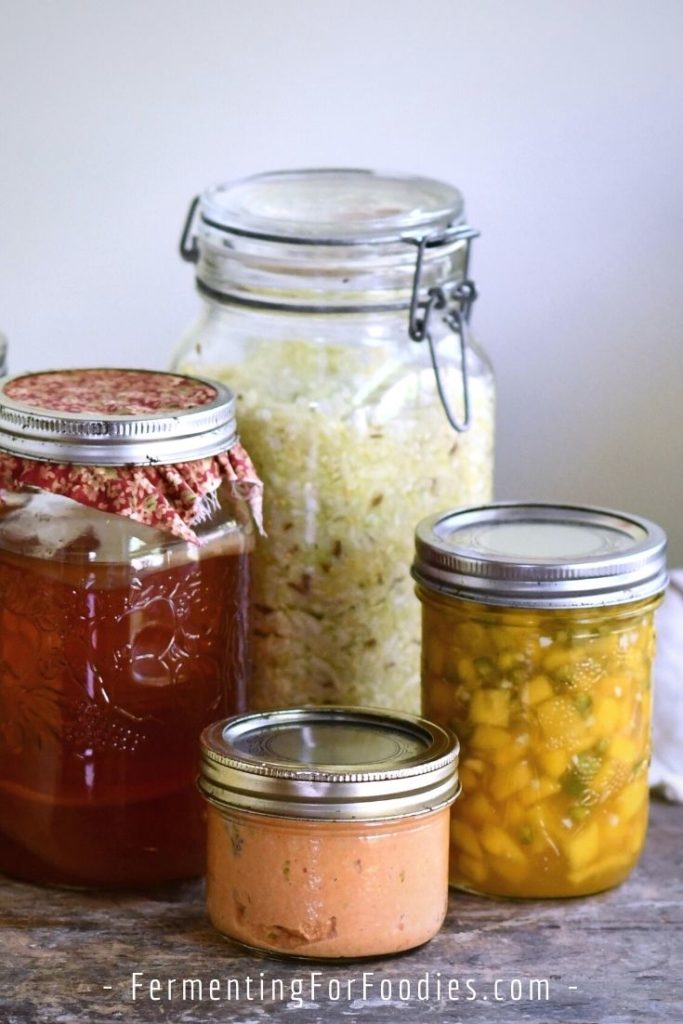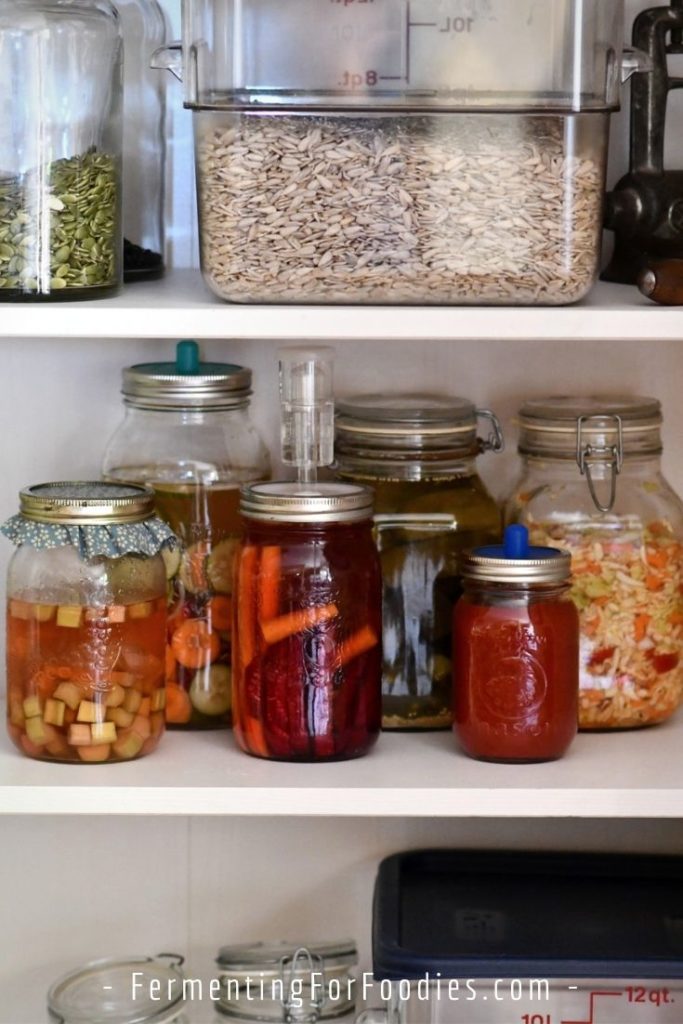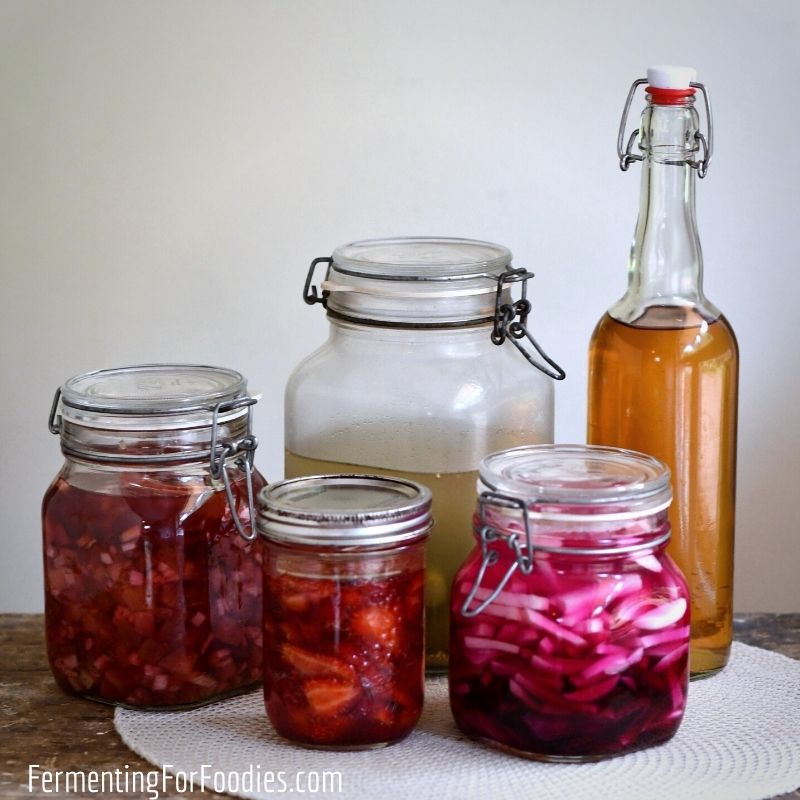Want to learn how to ferment? Here are five simple rules for success, whether you want to ferment vegetables, dairy, sourdough, or beer!

I started Fermenting For Foodies in 2014. Since then, I’ve tried fermenting pretty much EVERYTHING! I love it!
- It’s a super easy way to prepare and preserve food (pack it in a container and you’re done)!
- Homemade fermented foods are a great source of probiotics.
- They are simple and delicious.
If you are new to fermenting, here are a five rules to make sure that all your ferments are a success!
1. Keep everything clean
It is important to keep jars and kitchen utensils as clean as possible to prevent contamination from unwanted bacteria, yeasts, and molds. This is even more important if you’re planning on keeping your ferments for longer than a week.
- If it’s a quick ferment and you’ve never had issues with contamination, then it’s probably fine to use jars that have been well-washed.
- Always sanitize if you’re making anything that is going to ferment for more than a week.
- If you’ve had an issue with mold or kahm yeast, then sanitize the jars.
- The easiest way to sanitize is to pour boiling water over everything.
- I recommend using commercial sanitizers for ferments that require a particular culture, like beer, wine, and cheese.
Want more info? Here is a post specifically on how to clean and sanitize for fermenting.
2. What Temperature For Fermenting?
Fermenting at the right temperature is a good way to make sure that everything ferments at the optimal rate.
- Grain likes to ferment at 70F / 21 C. So stash your sourdough and other grain ferments near your hot water heater or above the fridge.
- Vegetables like to ferment at 63F / 18 C. Garages and basements are perfect for vegetable ferments. If you’re an urbanite… stash your vegetables in a cool-ish closet away from any heaters.
- Probiotic sodas like 70 F / 21 C. Sodas like kombucha, water kefir, and ginger bug will ferment very quickly at warmer temperatures, and slow down when it’s cool. The temperature will make the difference between your soda being ready in 24 hours (hot) to 5 days (cold).
- Alcoholic beverages range between 60 to 78F / 15 to 25 C. The ideal temperature will depend on the exact strains of yeast. In general, I recommend reading the yeast package to determine the best temperature for homemade beer or wine.
It’s not always easy to maintain the right temperature for fermentation. Don’t worry, just keep an eye on things and adjust the culturing time, as necessary. For example, in the winter, sourdough might need to rise for an extra few hours because it’s cold. In the summer, sauerkraut might finish fermenting within a few days rather than weeks because of the heat.
3. Storing Ferments
Once you’re done fermenting, always store your ferments somewhere cool. This will slow down the fermentation and increase the shelf-life. Traditionally, fermented foods were stored in a cellar or cold room, but the back of your refrigerator works too.
Cleanliness is still important during storage. So don’t double-dip your pickle fork!
Here is a post with more details on where you should store fermented foods both during fermentation and for the long term. And a post on the typical shelf-life of fermented foods.

4. How to avoid Cross-contamination between ferments
Fermenting cultures can cross-contaminate each other. For example, I’ve had milk kefir grow in my yogurt. And I’ve found that probiotic sodas can interfere with my sourdough.
- If you plan on keeping several different types of cultures, avoid having them sit next to each other while fermenting. The easiest way to prevent this is to keep your ferments in different closets or rooms.
- Keeping ferments separated is more important for wild cultured ferments, like sourdough, ginger bug, etc.
- It’s fine to have all your pickled vegetables in the same location. Or to store wine, cider, and beer in the same location. Just don’t mix your dairy cultures… they will definitely cross-contaminate.
5. What container should you use?
When most people think of fermenting, they think of a jar of sauerkraut, kimchi, or pickled green beans. However, there are so many different kinds of ferments that one-jar doesn’t work for them all!
Here are a few suggestions:
- In general, I prefer glass. It is non-reactive and won’t flavor the food. This is true whether I’m making sourdough starter or beer.
- If you are using plastic, don’t swap the container for a different type of ferment… no one wants dill pickle flavored yogurt!
- When you’re just starting, it’s fine to use whatever you happen to have in your kitchen. As you become more experienced, you will naturally get more supplies: airlocks for wine or fido jars for pickles.
- If you’re looking for more details here’s a post on containers for fermented vegetables.
What should you do if something is bad?
Fermented foods should never look or smell bad. It’s quite rare to have a ferment go bad. In my many years of fermenting, I’ve had to throw out about 5 things… and I make a lot of fermented food
Here are a few pieces of advice to help you avoid having a ferment go bad.
- Mold cannot grow in salt brine. That’s why fermented vegetables need to be kept below the salt brine. If there is mold on the surface of the brine, it can safely be removed without having harmed the fermented vegetables. Here’s a brine calculator to help you make sure your brine is salty enough.
- Kahm yeast is a free-range yeast that isn’t dangerous. It forms a thin layer across the top of a ferment. Wondering if you have kahm yeast? Here’s a post on the difference between mold and kahm yeast.
- If you have issues with mold in your house or you live in a heavily polluted city, it can be difficult to get started with wild ferments. Stick with store-bought cultures until you’ve got well-established wild yeasts and bacterial cultures in your home.
- The best way to keep the wrong kinds of bacteria, yeasts, and molds out of your ferments is to follow a good recipe. Healthy, vigorous cultures (whether it’s a kombucha SCOBY, sourdough starter, or jar of sauerkraut) will naturally out-compete any microbe that might cause it to go off. It’s why fermentation is such a great way to preserve food!
- If you are ever in doubt, throw it out.

Looking for some more advice?
There’s so much to know about fermentation. However, I want to assure you it is EASIER THAN YOU THINK.
There are really only three steps:
- Follow a tried and tested recipe. (All recipes on Fermenting For Foodies have been tested numerous times).
- Be patient. Fermenting always takes a bit of time to let the microbes do their thing.
- The ferment is done when it tastes good! That can be really quick (12 hours) or take up to several weeks. The exact timing is up to you. There are no wrong answers.
Feel free to check out all of the topics in the Fermenting Basics category. There’s a lot of information in there!
Different Types of Fermented Foods
Are you ready to get fermenting? Here are some of the wonderful foods that are made through fermentation!


I have a recipe for an ancho pepper sauce (that is NOT fermented.) What steps do I need to take to them this recipe into a fermentable one? 1) PH below 4.6? 2) make sure it’s 1.5 % or higher salt? 3) add whey? 4) none of these? Help! Thanks!!
Recipe: 1.5 oz dried ancho chiles, stemmed and seeded. 2c beef broth. 1 T minced canned chipotle Chile in adobo. 2T veg oil. 2 onions chopped. 6 cloves garlic. 1/4 c tomato paste. 1 t cumin. Salt.
Recipe from Cooks Illustrates Jan/Feb 2018
That looks delicious.
Hum… I would rework the recipe so that it was more like a fermented hot sauce. You can keep all the flavours, just not include the beef broth. Then add the chipolte (because of the adobo sauce) and oil (if needed?) after its fermented. Check out my hot sauce recipe as a start. https://www.fermentingforfoodies.com/archives/1862
Have fun!
Hi Emillie
I know nothing about fermenting but read a bit here. I googled fermenting because one of my blender drinks I had used buttermilk in and stored the residual fir about 5 or 6 days. It TASTES GOOD still (p has a frothy top ) so I was hoping it might be a healthy ferment. My concern is, I sometimes drink out of a
Jar and return it to the fridge (I live alone) So when I read your “do not double dip your pickle fork”, I thought I better not do that if I start to learn of fermenting.
White frothy top on fruit OK you think? Again, it tastes good!
Hi Zama,
If you used a cultured buttermilk, you probably have a nice healthy ferment. The white froth would be the bubbling buttermilk. Generally, fruit/milk combinations that have gone bad would either mold (so you would see mold) or become a yeasty-ferment (sparkling and alcoholic smelling.) If you stored your blender drink in the fridge and it seems fine, then it probably just fermented.
Double dipping is definitely best to avoid for things that are going to stay in the fridge for more than a week. It’s not always going to cause problems… but there’s definitely a risk! Cheers, Emillie
Why no fruit? anything and some pineapple and lots of sugar (cane) no fake
in a week 80 proof or is that 80% goodness
no ref leave it on the counter
I am in S. FLA there is always a BIG jar ready
need more drain most of the juice add fruit and sugar , juice makes a great start for frozen cocktails
Fermenting fruit is delicious! Sounds like you’re making fruit juice cider: https://www.fermentingforfoodies.com/archives/934
Had a sauerkraut batch go bad and was trying to figure out what went wrong when I came across your site. I like your articles a lot and find your writing style much preferable to other sources. Precisely what I was looking for. Thanks for the great content!
Thanks! And… I also have had sauerkraut go off! It’s rare, but I guess there’s always a risk of that happening.
Hi Emillie,
I live in Arizona and I keep my house around 80 degrees during the Summer. I made sauerkraut today but my coolest dark spot is about 78 degrees do you think its too warm? Would I better off keeping it in the refrigerator?
I recommend making sure it’s in a dark spot in your house, and fermenting for a 3-5 days. I wouldn’t leave it for a month at room temperature as the risk of yeast getting in there is higher with the heat. After 5 days at room temperature, put it in the fridge to finish. It won’t ferment quickly, but it will still continue to ferment.
Great thank you!
Brent
Made fermented Gaedarine following your recipe turned out great. My only question is im considering adding a little apple cider vinegar will that have any effect on the fermentation?
Adding cider vinegar to giardiniera would be nice. If you used fermented ACV (with a mother) then it could be used as to culture the ferment. Otherwise, feel free to add a bit afterwards for the flavour.
I’ve done several ferments, all with success. So, I just started a new one. This time, I thought I would use the leftover juice from a previous ferment. I thought that would make the ferment go faster, but it’s been two days, and still no air pressure in my air locks. I did mix ferment juice from 2 different ferments, so could the bacteria in the 2 ferments killed each other? Or, should I just keep waiting?
It really depends on what you used to ferment and what you are trying to ferment. Can you share more details? I often reuse culture. For example, I just packed carrots into my leftover kimchi brine. However, I’ve never tried to mix two ferments. If they are very different strains of yeast or bacteria, then there’s a chance they’re battling it out right now. 🙂 Maybe give it one more day (3 days total), if nothing is happening then stash it in the fridge so you can at least save the food from potentially spoiling. Good luck!
I know othing about fermenting and would like to learn. First off, do you leave space in the top of the jars or can you fill it up.
Yes! Always leave space. Most ferments bubble up. So leave about 2 inches in the top of a quart jar for vegetable and fruit ferments. And expect sourdough ferments to double in size. 🙂
HI, for college my group and I are doing some research about fermentation.
My question is; can you start fermenting right away, or do you think you need some basic knowledge about fermentation and possible risks? If yes, can you learn that in a day or does it take weeks (or longer) to know enough about fermentation to begin?
thanks in advance,
Noa 🙂
You can totally start fermenting right away! I usually recommend sauerkraut, since cabbage comes with its own lactic culture. You just pack it into a jar and leave it in a dark cupboard to ferment. Here’s my recipe: https://www.fermentingforfoodies.com/easy-fermented-sauerkraut/ Good luck!